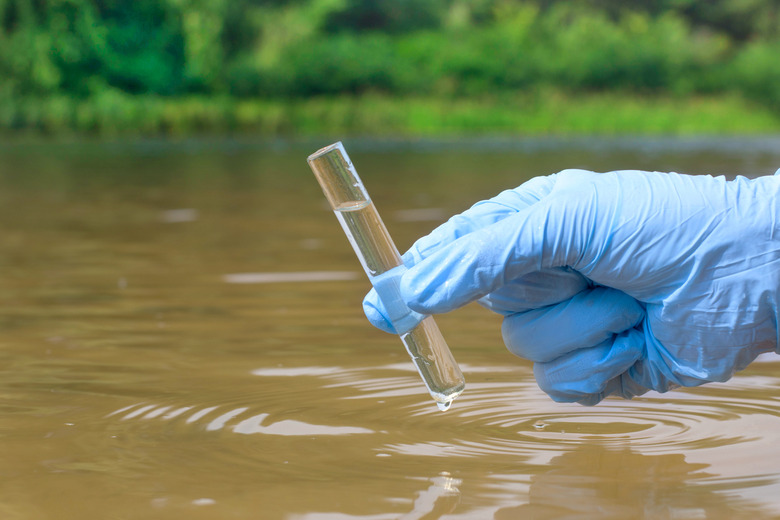How To Calculate Bicarbonate Concentration
When carbon dioxide dissolves, it can react with water to form carbonic acid, H2CO3. H2CO3 can dissociate and give away one or two hydrogen ions to form either a bicarbonate ion (HCO3-) or a carbonate ion (CO3 w/ -2 charge). If dissolved calcium is present, it reacts to form insoluble calcium carbonate (CaCO3) or soluble calcium bicarbonate (Ca(HCO3-)2). If you're testing water samples for environmental health and/or water quality, you may need to calculate bicarbonate concentration. To calculate bicarbonate concentration, you'll first need to find total alkalinity for your sample. Testing total alkalinity is beyond the scope of this article; if you need to know how to do so, the link under "Resources" provides full instructions.
Step 1
Convert from total alkalinity to molarity. Total alkalinity is usually a measure of milligrams per liter of calcium carbonate; divide by 100,000 (approximately) grams per mole to find moles per liter or molarity. Molarity is the concentration of a substance in a solution.
Step 2
Substitute the equation for carbonate concentration as a function of bicarbonate concentration and pH for the equation for total alkalinity. The expression for total alkalinity is 2 x total alkalinity = [HCO3-] + 2 [CO3 -2] + [OH-]. (Note that in chemistry, the brackets around a species refer to its concentration, so [HCO3-] is the concentration of bicarbonate). The equation for carbonate concentration is [CO3 -2] = K2 [HCO3-] / [H+], where K2 is the second dissociation constant for carbonic acid. Substituting this expression will give us 2 x total alkalinity = [HCO3-] + 2 x ( K2 [HCO3-] / [H+] ) + [OH-].
Step 3
Rearrange this equation to solve for [HCO3-]. Since pH = -log [H+], [H+] = 10 to the negative pH. We can use this information and some algebra to rewrite the equation as [HCO3-] = ( 2 x total alkalinity ) – ( 10 to the (-14 + pH) ) / ( 1 + 2K2 x 10 to the pH).
Step 4
Plug the value for moles per liter of calcium carbonate you found previously into the equation to find bicarbonate concentration.
Things Needed
- Total alkalinity of your sample
- pH of your sample
- Pencil
- Paper
- Calculator
- Second dissociation constant for carbonic acid, which is 5.6 x 10 to the -11
Warning
The formula will work only if calcium and carbonate compounds make up the bulk of the contribution to total alkalinity. If you suspect other compounds like ammonia are present, a more complex formula will be required; see the first link under the "References" for details.
References
Cite This Article
MLA
Brennan, John. "How To Calculate Bicarbonate Concentration" sciencing.com, https://www.sciencing.com/calculate-bicarbonate-concentration-7251238/. 13 March 2018.
APA
Brennan, John. (2018, March 13). How To Calculate Bicarbonate Concentration. sciencing.com. Retrieved from https://www.sciencing.com/calculate-bicarbonate-concentration-7251238/
Chicago
Brennan, John. How To Calculate Bicarbonate Concentration last modified August 30, 2022. https://www.sciencing.com/calculate-bicarbonate-concentration-7251238/
